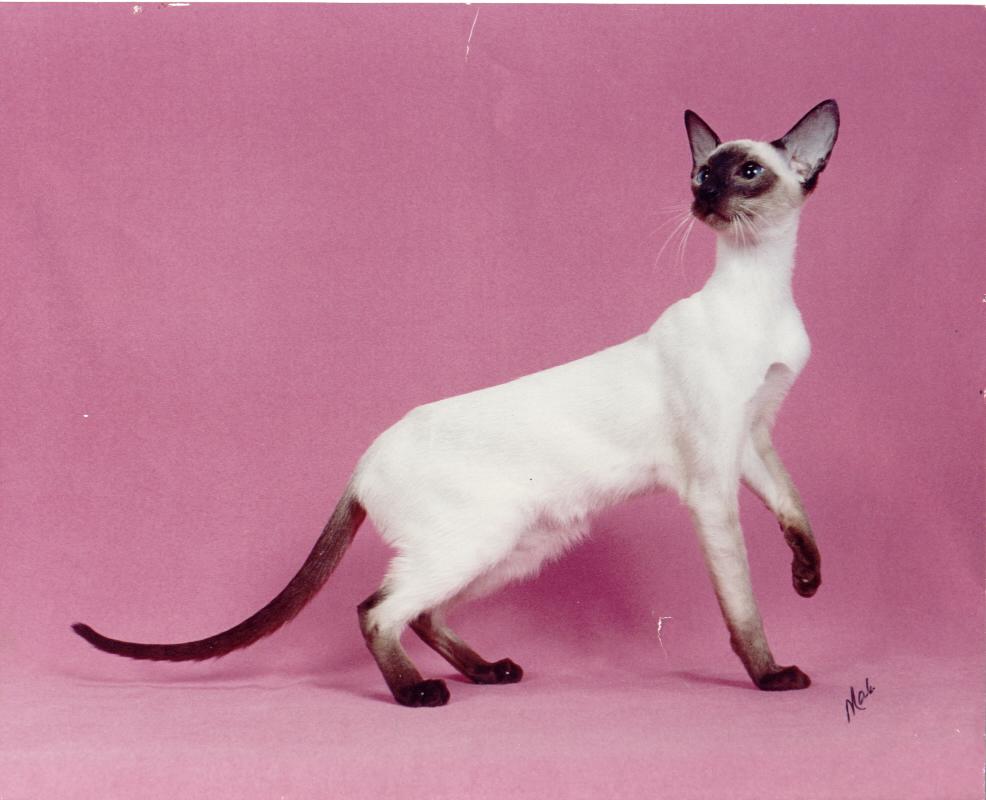Thai Cat or Traditional Siamese

The Thai cat is an ancient breed that has recently been renamed. It is related to modern Siamese cats, but differs from them. This breed originated in the ancient kingdom of Siam, now Thailand. From 1880 it was commercialized and shipped to Great Britain and later to the United States.
The Thai and Western Siamese share common ancestors, but after World War II separate breeding resulted in two different breeds. The modern Western Siamese became the predominant Siamese variety worldwide due to its more extreme characteristics, which were more popular in cat show districts.
- The Modern Siamese cat is more carefully refined and is characterized by blue, almond-shaped eyes, a triangular head shape, large ears, an elongated, slender and muscular body.
- The traditional or Thai Siamese cat is probably the best known. The main characteristic that distinguishes the Thai breed from the modern Siamese cats is their body type. The Thai breed is more elongated than the average Western domestic cat, but significantly less so than the modern Siamese or Oriental.
Both varieties are characterized by their typical pointed color scheme, the dark coloration where the body temperature is lower (limbs, tail, face, and ears), which contrasts with the decrease tones of the cat body.
- Asia
- Thailand
- Category IV
- 7-11
- 11-13
- 13-17
- 17-22
- 22-30
- 8-10
- 10-15
- 15-18
- 18-20
Origin of the Thai cat
The Thai cat is considered one of the most popular breeds in the world. However, its history holds some mysteries and uncertain origin. It is believed that it originated in Thailand (ancient Siam), although there are also many legends that refer to Ancient Egypt, where cats resembling Thai cats were revered.
The first official records of their existence date back to the 17th century from the Kingdom of Siam (now Thailand), where they were only allowed to be kept as pets of the royal family, hence one of their first names "Royal Cat of Siam". It was believed that these cats had special powers and were responsible for guarding some treasures of princes and princesses.
Although the exact year they were introduced to Europe is not known, it is believed that it was towards the end of the 19th century when the sister of the British Consul in Bangkok received a pair of Thai cats as a gift. This is only a historical starting point, as the breed may have arrived at other continents several years earlier.
Physical characteristics of the Thai cat
This oriental cat breed is athletic, but not as exaggeratedly slender as the Siamese.
- The good proportions and muscular neck give it a solid structure.
- The shape of the Thai cat's head is very characteristic and differs from the modern Siamese. The long, flat forehead leads to a round skull and a well-proportioned muzzle. The chin and the bridge of the nose form a straight line.
- The ears are set high and wide apart, unlike those of the Siamese.
- The two breeds have in common the almond-shaped eyes of intense blue color, which are wide apart and slightly slanted. The blue color is due to the fact that Siamese cats are partially albino. They produce only a small amount of the pigment melanin, which is also the reason for the special coloring of their fur.
- The coat of this short-haired cat reflects the tropical climate of its South Asian origin. It has little undercoat, is silky and has a beautiful sheen.
Thai cat coat colors
The four basic colors of Thai cats are:
- Seal
- Blue
- Chocolate
- Lilac
- Red and cream
The extremities must be uniformly colored. They are always darker than the rest of the base coat, which is basically white with a sheen of the corresponding point color.
Character of the Thai car
They are conspicuous for their hyperactivity. This is common in cats of Asian origin, as is their amazing agility. They are happy, fun and affectionate companions. They are also active and friendly cats that love to play and can get into mischief out of boredom.
They are not only affectionate and sociable, but also a good companion for young and old. However, if you do not give it enough attention, it can become depressed. Besides, these cats are great reapers, making various sounds to express their feelings.
Depending on the cat's character, we can have very sociable and curious Thai cats, but in rarer cases we can have a fearful cat that feels uncomfortable when new people arrive in the house.
Health of the Thai cat
The Thai cat usually enjoys good health, as evidenced by its average life expectancy of 15 years. Nevertheless, as with all breeds, there are diseases that occur more frequently:
- Strabismus
- Respiratory infections caused by viruses or bacteria
- Heart diseases
- Poor circulation
- Obesity in old age
- Ear infection
- Deafness
It is always important to schedule regular wellness visits with your cat's veterinarian and to always watch for signs that your cat is in distress or in pain. Continue reading this other article if you want to learn more about the most common diseases and health problems of this breed.
Care of the Thai cat
The Thai cat is a particularly clean and calm breed that spends a lot of time grooming itself. For this reason, brushing them once or twice a week is enough. Your veterinarian can help you develop a grooming routine that will keep your cat healthy.
The Thai cat's ears should be checked regularly for signs of dirt buildup or possible infection.
It is also important that you provide them with physical exercise to maintain their characteristics such as speed, strength, and figure. You should also get a scratching post for your Thai cat's living environment. This can promote healthy scratching and keep your cat's nails in good condition.
Finally, your Thai will appreciate a sturdy scratching post to play and interact with. This will help keep the kitty stimulated and content and may prevent behavior problems.
Where to adopt a Thai cat
For your Thai cat to live happily for many years, you just need to buy it from a responsible breeder. For these breeders, the cat's health is their top priority. They test the animals for hereditary diseases at an early stage and select the breeding animals very well. Stay away from ads for cheap pedigreed cats. These cats usually come from people who breed them unscrupulously and who are not concerned with the health of the animals, but with making a quick buck.
If you want to buy a Thai cat and do something good at the same time, animal shelters are a good alternative. Since the Thai cat is such a popular breed, there are usually many purebred cats looking for a family.
Thai Cat or Traditional Siamese photos


















